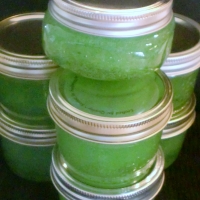Basil Jelly
From champagnetime 11 years agoIngredients
- 4 cups water shopping list
- 2 cups firmly packed fresh basil leaves -- finely chopped shopping list
- 1 package powdered fruit pectin -- (1-3/4 ounces) shopping list
- 3 drops green food coloring -- optional shopping list
- 5 cups sugar shopping list
How to make it
- In a large saucepan, bring water and basil to a boil. Remove from the heat; cover and let stand for 10 minutes.
- Strain and discard basil. Return 3-2/3 cups liquid to the pan. Stir in pectin and food coloring if desired. Return to a rolling boil over high heat.
- Stir in the sugar. Boil for 1 minute, stirring constantly. Remove from the heat; skim off foam.
- Carefully ladle hot mixture into hot half-pint jars, leaving 1/4-in. headspace. Remove air bubbles, wipe rims and adjust lids.
- Process for 15 minutes in a boiling-water canner. Yield: 6 half-pints. Allow jelly to set up 5 days before using.
- Note: The processing time listed is for altitudes of 1,000 feet or less. Add 1 minute to the processing time for each 1,000 feet of additional altitude.
- Using Basil Jelly:
- An old friend, Labs, suggested: Layer slice of mozzarella on a cracker, top with a dab of basil jelly and tomato jam – Caprese Salad takeoff.
- Topping a cream cheese cracker
- Combine with barbecue sauce; simmer and add mini meatballs or cocktail wieners.
- My favorite: slather a toasted bagel and top with the jelly.
- Source: discussed on a cooking forum years ago.
People Who Like This Dish 3
- MissouriFarmWife Ozarks, Missouri
- clbacon Birmingham, AL
- twertsfirst McDonough, GA
- champagnetime Straits Of Juan De Fuca, WA
- Show up here?Review or Bookmark it! ✔



Reviews & Comments 5
-
All Comments
-
Your Comments